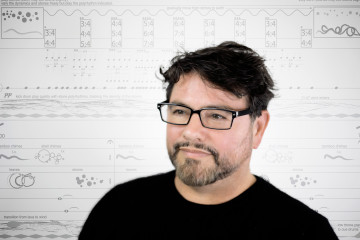Reef Generations
"Reef Generations" by Matthew Burtner is a data artwork about oyster reef restoration on the Virginia eastern shore. Using data collected by University of Virginia environmental scientists working at the Virginia Coast Reserve (VCR), the piece synthesizes an audio-visual computer-generated environment that explores the marvelous underwater generation of oyster reefs and their function as a living seawall attenuating wave motion and storm surge from rising sea levels.
Oyster reefs offer many benefits for coastal habitats. They protect the shore from wave motion, mitigate erosion, filter chemical toxins like pesticides from the ocean, absorb greenhouse gasses such as nitrogen and carbon dioxide, provide a habitat for many species, and offer sustenance to humans and other animals. "Reef Generations" focuses on the reef as a living seawall, protecting the coast from the effects of erosion due to sea level rise and increased storm activities caused by global warming.
Burtner visualizes and sonifies data sets collected by VCR scientists Matt Reidenbach, Libby Bieri, and Sara Hogan across years of dramatic reef growth. Environmental data such as wave height, oyster count, and abiotic population growth are correlated in the algorithmic design, producing computer-generated animation and synthesized music. The piece also uses a stereo underwater field recording of the reef habitat, recorded by Burtner in collaboration with UVA’s Coastal Conservatory. This recording provides important clues about the health of the reef, and through spectral analysis the audio recording becomes a dynamic data set for resynthesis in the music and animation.
While the piece uses scientific data to generate the visual-audio system, Burtner hopes it will be experienced as a poetic reflection on the data and that it will inspire curiosity in viewers who may then recognize the importance of the science and the reef restoration efforts. Ultimately, oyster reef restoration efforts are a rare example of human nature symbiosis, worthy of recognition as a phenomenon we rarely observe in the Anthropocene.
Sources
- Bieri, E. (2022). Evaluating Coastal Protection Benefits of Restored Oyster Reef Designs (master's thesis; advisors: Matthew Reidenbach and Patricia Wiberg). University of Virginia.
- Burtner, M. (2022). Oyster Reef Field Recording, stereo hydrophone recorder. Location: Hog Island, Coastal Conservatory.
- Hogan, S., Reidenbach, M. (2000). Data for quantifying ecosystem services under various oyster reef designs. Virginia Coast Reserve Long-Term Ecological Research Project Data, Publication knb-lter-vcr.344.2.

Matthew Burtner
Matthew Burtner is an Alaskan-born composer, sound artist, and eco-acoustician whose work explores embodiment, ecology, polytemporality, and noise. His music has been performed in concerts around the world and featured by organizations such as NASA, PBS NewsHour, the American Geophysical Union, the BBC, the U.S. State Department under President Barack Obama, and National Geographic. He has published three intermedia climate change works, including the IDEA Award-winning telematic opera, "Auksalaq." In 2020 he received an Emmy Award for “Composing Music with Snow and Glaciers,” a feature on his Glacier Music by Alaska Public Media. His music has also received international honors and awards from the Musica Nova (Czech Republic), Bourges (France), Gaudeamus (Netherlands), Darmstadt (Germany), and The Russolo (Italy) international music competitions. He is the recipient of a National Endowment for the Arts Award for "The Ceiling Floats Away," a large-scale collaborative work with U.S. Poet Laureate and Pulitzer Prize-winning writer Rita Dove.
Burtner is the Eleanor Shea Professor of Music at the University of Virginia where he co-directs the Coastal Future Conservatory. He also is founder and director of the ecoacoustics nonprofit organization EcoSono.
Burtner’s new album, "Profiled from Atmospheres," will be released in 2024.
